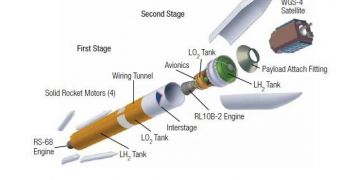The US Air Force (USAF) is getting ready to launch a new, extremely important satellite tonight, January 19. The spacecraft, which has been under construction and development for the past 5 years, is now finally ready to be deployed, and assist soldiers on the battlefield.
The primary function of the Wideband Global SATCOM 4 spacecraft will be to provide high-throughput communication capabilities to military assets in foreign theaters of operations. Being able to get messages across in a rapid, reliable manner could mean the difference between life and death.
WGS 4 is part of a planned satellite constellation that the US Defense Department wants to deploy to orbit as soon as possible. The thing that will separate this constellation from its predecessors is the fact that it will be able to support communications at ten times the previous speed.
The spacecraft that will launch tonight from the Cape Canaveral Air Force Station (CCAFS) was developed by the Boeing Company, under a 2006 contract worth $464 million. Takeoff needs to occur during a launch window lasting between 7:38 to 9:11 pm EST (0038 to 0211 GMT), Space reports.
“The team is focused on mission success and getting this critical capability to the warfighter by launching the most advanced wideband satellite system in the world,” says Dave Madden.
The expert, who is the director of the Military Satellite Communications Systems Directorate at the USAF Space and Missile Systems Center, added that this spacecraft is the first to be launched in the US after the mishap that plagued the Advanced Extremely High Frequency 1 satellite, in August 2010.
AEHF-1 experienced a major issue upon reaching orbit, when its main propulsion system failed to engage. This stranded the expensive spacecraft in an unsuitable orbit, and set back the USAF considerably. Needless to say, authorities want to avoid a similar occurrence in the future.
This is why Boeing checked and double-checked WGS 4's thrusters, even though the company has an excellent track record, and was not in charge of building AEHF-1. The new spacecraft will be launched aboard a Delta 4 Medium+ delivery system.
“Yes, we did check out the propulsion fuel lines […] This system has an apogee engine similar to Advanced EHF, so we went back and thoroughly checked all of the lines,” Madden said to the media.
“To make sure I felt comfortable, I had them do an extra check of the propellant lines to make sure we didn't have any similar issues. Get me once, but not twice,” the official concluded.

 14 DAY TRIAL //
14 DAY TRIAL //